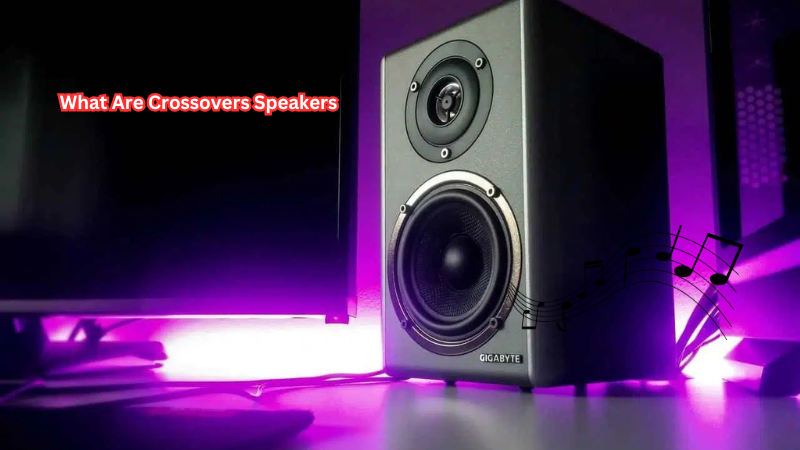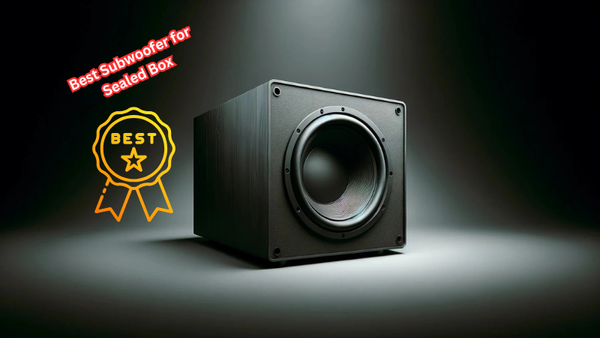Crossover speakers play a key role in delivering high-quality sound by dividing an audio signal across different speaker drivers.
At the heart of this process is the crossover point, or cutoff frequency, where audio frequencies are split to ensure that each driver handles only the frequencies it’s designed for. High frequencies, for instance, are directed to the high-frequency driver, while lower frequencies go to other drivers.
Passive crossovers, commonly found in home and car speakers, manage this separation without needing external power, enhancing sound quality. By setting the right crossover frequency, crossover speakers create a balanced and clear listening experience across all audio ranges.
Understanding the Basics of Crossover Speakers
To fully comprehend the significance of crossover speakers, let's dive into some basic details about how they function.
First and foremost, it’s essential to understand that different audio frequencies require different-sized drivers to produce sound efficiently. While smaller drivers can handle high frequencies well, larger ones are more suited for low frequencies.
This is where crossover speakers come in – they ensure that each driver receives only the frequency range it can handle best. This prevents distortion and improves overall sound quality by directing each frequency to the appropriate driver.
Types of Crossover Speakers
There are two main types of crossovers: passive and active. Passive crossovers, as mentioned earlier, do not require external power and are found in most home and car audio systems. They use simple circuits consisting of capacitors, resistors, and inductors to divide the audio signal.
On the other hand, active crossovers are powered by an external power source and require a separate amplifier for each driver. This allows for more precise frequency control and better sound quality since each driver receives its own amplified signal.
Within these two main types, there are also different designs such as high-pass, low-pass, and band-pass crossovers. Each has its unique purpose and effect on the sound produced.
Frequency Ranges in Crossover Speakers
Passive crossovers typically have a fixed crossover frequency set by the manufacturer and cannot be adjusted. This makes them simple to use and install, but may not provide the most precise sound control. On the other hand, active crossovers allow for adjustments to the crossover frequency, allowing for more customization of the sound output.
One common type of passive crossover is known as a high-pass filter. This filters out lower frequencies and only allows higher frequencies to pass through to the appropriate driver. High-pass filters are often used in combination with tweeters or smaller drivers that excel at handling high frequencies.
Low-pass filters, on the other hand, do the opposite – they filter out higher frequencies and only allow lower frequencies to pass through. These are often used with larger drivers, such as woofers or subwoofers, that are better at handling low frequencies. In low pass filter design, the crossover point is known as the "roll-off frequency," where the driver's output begins to decrease.
Finally, band-pass crossovers combine both high-pass and low-pass filters to allow a specific frequency band to pass through. This can be useful for creating a more focused sound in a particular frequency range.
Benefits of Crossover Speakers
Crossover speakers offer several benefits that make them an essential component of any high-quality sound system. Here are just a few:
Improved Sound Quality
One of the main benefits of using crossover speakers is their ability to improve sound quality. By dividing audio frequencies among different drivers, each speaker is able to handle its designated range more efficiently. This prevents distortion and creates a balanced and clear sound across all frequency ranges.
Enhanced Speaker Protection
Another advantage of crossovers is that they help protect speakers from damage. By directing specific frequencies to the appropriate drivers, crossover speakers prevent low-frequency sounds from being sent to smaller drivers, which could potentially be damaged by handling them.
More Precise Sound Control
Active crossovers offer the added benefit of allowing for more precise sound control. By adjusting the crossover frequency, users can customize the sound output to their liking. This allows for a more personalized listening experience and can be especially useful in certain musical genres or audio recordings.
Cost-Efficient Solution
Passive crossovers are typically more cost-efficient compared to active crossovers since they do not require an external power source. Additionally, many speakers come with built-in passive crossovers, making it easier and more affordable to implement them into a sound system.
Versatile Applications
Crossover speakers have a wide range of applications, from home audio systems to car audio systems and even professional sound setups. This versatility makes them a valuable component in various audio environments and ensures that users can enjoy high-quality sound no matter where they are.
Active crossover speakers, in particular, are often used in professional audio setups such as concerts and live performances due to their ability to provide precise sound control. In speaker crossover design, the possibilities are endless and can be tailored to suit different audio setups and preferences.
Types of Crossovers in Speaker Systems
Aside from the two main types of crossovers, different configurations can be used in speaker systems. Some common types include:
2-way Crossover
A 2-way crossover involves dividing the audio signal into two frequency ranges – low and high frequencies. This is commonly used in bookshelf speakers and car audio systems.
3-way Crossover
A 3-way crossover divides the audio signal into three frequency ranges – low, mid, and high frequencies. This is often used in larger home speakers or professional sound setups where more precise sound control is required.
4-way Crossover
In a 4-way crossover system, the audio signal is divided into four frequency ranges – low, low-mid, high-mid, and high frequencies. This provides even more precise sound control and is commonly used in high-end audio systems.
Frequency bands and crossover points can also be adjusted in each of these configurations, allowing for further customization of the sound output. Frequency response graphs can be used to visualize how different crossover configurations affect the sound produced by a speaker system.
How to Do Crossover Frequency Settings and Adjustments
For passive speakers, crossover frequency settings are typically already predetermined by the manufacturer and cannot be adjusted. However, for active speakers, adjustments can be made using either a built-in control panel or an external processor.
When adjusting crossover frequency settings, here are a few tips to keep in mind:
- Start with default settings: Before making any adjustments, start by using the default crossover frequency settings provided by the manufacturer. This will give you a baseline to work from and ensure that your system is functioning properly.
- Consider room acoustics: The acoustics of the room where the speakers will be used can greatly impact the sound produced. Take into account factors such as room size, shape, and materials used when adjusting crossover frequencies for optimal sound quality.
- Use test tones: Playing test tones at different frequencies can help identify any peaks or dips in audio response, allowing for more precise adjustments of crossover frequencies.
- Make small adjustments: It's best to make small adjustments to crossover frequencies, as drastic changes can result in significant differences in sound output. Start by adjusting one frequency band at a time and listen carefully for any changes before moving on to the next band.
- Experiment and fine-tune: Adjusting crossover frequencies is not an exact science, and experimenting with different settings can help you find the perfect balance for your specific audio setup and preferences.
Applications of Crossover Speakers in Different Audio Systems
As mentioned earlier, crossover speakers have a wide range of applications in various audio systems. Some common examples include:
Home theater systems:
Crossover speakers are commonly used in home theater systems to create a more immersive and balanced sound experience. By dividing audio frequencies among different speakers, home theater systems can provide a more accurate and dynamic sound output.
Car audio systems:
Car audio systems often use crossover speakers to enhance the overall sound quality and prevent damage to smaller drivers. Crossovers also allow for better control over the bass, mid-range, and treble frequencies in a car’s limited space.
Professional sound setups:
Crossover speakers are an essential component in professional sound setups such as concerts, live performances, and recording studios. They provide precise sound control and help create a balanced and high-quality sound output.
Common Mistakes and Troubleshooting Tips
As with any audio equipment, some common mistakes can affect the performance of crossover speakers. Here are a few troubleshooting tips to help fix these issues:
- Incorrect wiring: Make sure to double-check all connections and ensure that the positive and negative terminals are properly connected.
- Improper placement: Placing crossovers too close to other electronic devices or near sources of interference can result in distorted sound output. Keep them away from potential sources of interference for optimal performance.
- Inadequate power supply: Active crossovers require external power sources, so make sure they are receiving enough power to function properly.
- Overlapping frequency bands: If certain frequencies are not being produced or sound distorted, it could be an indication of overlapping frequency bands. Adjust crossover frequencies to avoid overlap and ensure a smooth transition between different frequency ranges.
- Old or damaged components: If all troubleshooting methods fail, the issue may lie with old or damaged crossover components. In this case, replacement may be necessary for optimal performance.
FAQs
Can I use a crossover speaker in my home audio system?
Yes, crossover speakers can be used in various home audio systems for improved sound quality and balance.
How do I know which crossover configuration is right for my setup?
It depends on the type of speakers you have and your personal preferences. It's best to experiment with different configurations and fine-tune the settings to find the perfect balance for your specific setup.
Can I adjust crossover frequency settings while music is playing?
While it is possible, it is not recommended to make adjustments while music is playing as this can result in sudden changes in sound output that may be disruptive or damaging to the speakers. It's best to pause or stop playback before making any adjustments to crossover frequencies.
Conclusion
Crossovers are an essential component in speaker systems, allowing for better sound control and an overall enhanced audio experience.
Understanding the different types of crossovers, how to adjust frequency settings, and common troubleshooting tips can help you get the most out of your speaker system.
Also, remember to keep experimenting and fine-tuning your crossover settings to find the perfect balance for your specific audio setup. With proper use and care, crossovers can greatly improve the performance of any speaker system.





